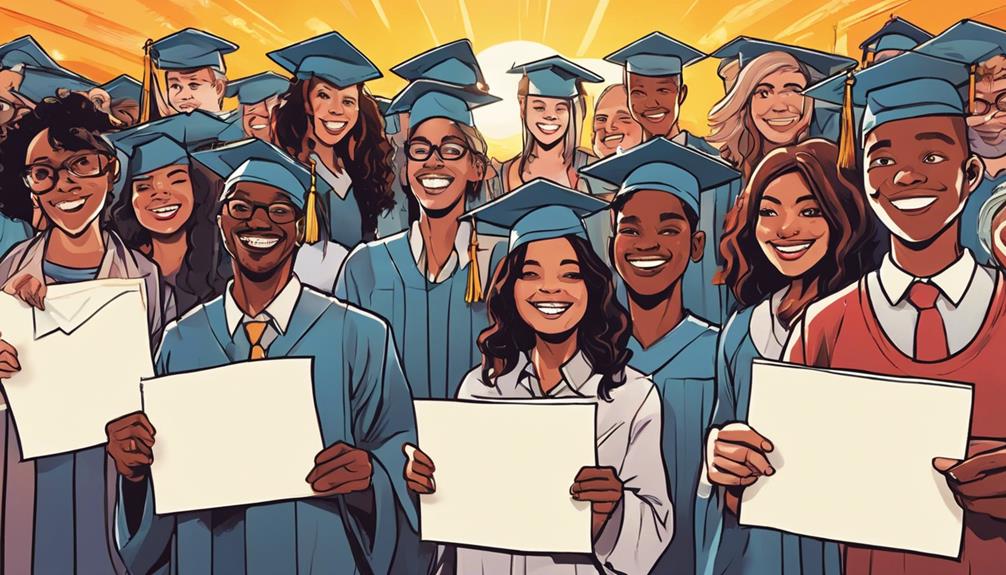Teachers transform classrooms by making **inclusive spaces** that **celebrate diversity**. They mix technology with traditional methods, making learning **fun and interactive**. **Critical thinking** grows through projects and teamwork, helping kids tackle problems. **Student well-being** gets a boost with talks about mental health and **mindfulness prompts**. **Assessments change**, focusing more on projects to show real student growth. This **inclusive future** ensures every voice matters, helping students thrive in all areas. **Discover more** about these amazing classroom strategies waiting to be explored.
Key Takeaways
- Embrace multiculturalism through diverse teaching materials.
- Encourage open discussions where every voice is heard.
- Create safe spaces for authentic expression.
- Prioritize inclusivity for a thriving diverse classroom.
- Celebrate various holidays and traditions.
Fostering Inclusive Learning Environments
Creating an inclusive learning environment is foundational to cultivating a diverse and welcoming classroom that values the contributions of all students. By embracing multiculturalism through diverse teaching materials and celebrating various holidays and traditions, educators can foster an atmosphere of respect and understanding. Encouraging open discussions where every student's voice is heard helps shape compassionate and empathetic individuals ready to engage with the world around them.
It is essential to create a space where students feel safe to express themselves authentically and learn from one another's unique perspectives. By prioritizing inclusivity, educators lay the groundwork for a classroom that thrives on diversity and mutual respect, setting the stage for a truly enriching educational experience.
Balancing Tech and Tradition

Finding equilibrium between technological advancements and traditional teaching methods is essential in modern educational settings. While technology offers innovative tools for learning, traditional methods hold value in fostering personal connections and deepening understanding. By blending the two, educators can create a dynamic learning environment that caters to diverse student needs.
Embracing educational technology can enhance student engagement and provide interactive learning experiences. However, maintaining face-to-face interactions is vital for building relationships and promoting effective communication skills. Striking a balance between digital innovation and human connection is key to ensuring students receive a well-rounded education.
As education adapts to the changing landscape post-pandemic, it is imperative for teachers to continue integrating technology while upholding the importance of traditional teaching approaches.
Cultivating Critical Thinkers

Promoting the development of critical thinking skills is paramount in shaping well-rounded students prepared for the challenges of a rapidly evolving world. By encouraging students to think analytically and creatively, educators cultivate individuals who can navigate complexity, solve problems, and make informed decisions.
Assigning projects that require innovative problem-solving, fostering collaboration among peers, and equipping students with adaptable tools are key strategies in nurturing critical thinking abilities. These skills not only enhance academic performance but also prepare students for success in a dynamic and unpredictable future.
Cultivating critical thinkers empowers students to approach challenges with resilience, adaptability, and a mindset geared towards continuous learning and growth.
Prioritizing Student Well-being

Fostering a culture of well-being is essential in ensuring students' holistic development and academic success. To prioritize student well-being effectively, teachers can:
- Promote Mental Health: Support students by creating a safe space for open discussions on mental health challenges.
- Incorporate Mindfulness: Integrate mindfulness exercises into daily routines to help students manage stress and focus better.
- Encourage Breaks: Allow students time to recharge by incorporating regular breaks during class to prevent burnout.
- Nurture Emotional Well-being: Pay attention to students' emotional needs by providing resources and support to maintain a healthy emotional state.
Rethinking Assessment Methods

How can educators innovate assessment methods to better align with the evolving needs of students in a rapidly changing educational landscape?
In response to this question, teachers are rethinking traditional assessment practices to create a more inclusive and effective evaluation process. Moving away from rigid exams, educators are embracing project-based evaluations, utilizing portfolios, and encouraging real-world applications of knowledge.
By allowing students to showcase their skills in diverse ways, such as through presentations, creative projects, or practical demonstrations, assessments become more reflective of students' abilities and learning styles.
This shift towards flexible assessment methods not only provides a more accurate representation of student progress but also fosters a deeper understanding of the material and promotes critical thinking and creativity in learners.
Frequently Asked Questions
How Can Teachers Address Cultural Diversity in the Classroom?
Teachers can address cultural diversity in the classroom by creating an inclusive environment, embracing multiculturalism, celebrating various holidays, encouraging open discussions, and fostering empathy. Using diverse teaching materials and valuing students' backgrounds are key strategies.
What Strategies Can Help Maintain a Balance Between Technology and Traditional Teaching Methods?
To maintain a balance between technology and traditional teaching methods, educators can blend innovative edtech tools with face-to-face interactions. By embracing digital innovation while upholding the value of human connection, teachers can adapt their methods to engage students effectively in a post-pandemic educational landscape.
How Can Educators Encourage Students to Think Critically and Adapt to Change?
Educators foster critical thinking by challenging students to analyze, question, and adapt to change. Encouraging problem-solving projects, collaboration, and lifelong learning skills cultivates adaptable individuals ready for a dynamic world.
What Initiatives Can Be Implemented to Prioritize Student Mental Health and Well-Being?
To prioritize student mental health and well-being, educators can create safe spaces for discussions, incorporate mindfulness exercises, provide breaks for recharging, and nurture emotional well-being. Supporting students' mental health is essential for holistic development.
How Can Assessment Methods Be Tailored to Showcase Diverse Student Skills and Knowledge?
Assessment methods can be tailored to showcase diverse student skills and knowledge by moving towards project-based evaluations, portfolios, and real-world applications. This approach allows students to demonstrate their abilities through various creative and practical means.
Conclusion
To sum up, teachers are leading the way in revolutionizing classrooms to create inclusive and empowering learning environments.
By prioritizing diversity, embracing technology, nurturing critical thinking skills, prioritizing student well-being, and rethinking assessment methods, educators are shaping a future where all students can thrive.
This transformation in education is essential for preparing students to succeed in a rapidly changing world, highlighting the importance of inclusivity and innovation in the classroom.










